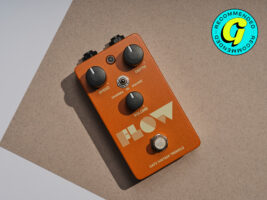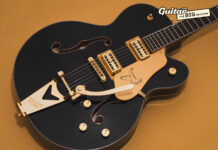
Universal Audio UAFX Flow review – the ultimate compact tremolo pedal?
$199/£189, uaudio.com
Universal Audio’s move into the world of effects has been an interesting if slightly messy affair. On the one hand, guitarists the world over have gone ga-ga over the fact that UA’s studio-quality amp and effects simulations are now available in gig-ready pedal format. On the other, complaints about missing features, dubiously functional companion apps, and the high cost of entry have dogged the UAFX range, and taken some of the shine off a line that was initially greeted with a huge amount of hype and enthusiasm.
READ MORE: Universal Audio’s UAFX Brigade: an elegant take on the OG chorus pedal
It’s into this world that UAFX’s compact pedals have emerged in the last year or two – and again things have been decidedly mixed. On the one hand, these pedals offer undeniably great sounds at more accessible prices. But on the other, they’re still very expensive and in several cases feature sounds that have dubious utility as a standalone units.
That said, I was pretty impressed with the Brigade chorus pedal a little while back, and so I’m hoping that UA can repeat the feat here with a vintage-style tremolo – the Flow.
UAFX Flow knobs. Image: Adam Gasson
What is the UAFX Flow?
In essence, the Flow is an emulation of a classic tube-powered tremolo tone – think the woozy sound of a classic Fender amp tremolo. As with the rest of the UAFX compact range, the Flow effectively boxes up one of the modes of one of the bigger UA pedals, in this case it’s borrowed from the impressive Astra Modulation Machine.
There are three distinct sounds on tap. First up and perhaps most predictably we have ‘65’ which – you won’t need the help of Bletchley Park to decode – is attempting to emulate that most famous of amp tremolos – the optical throb of a 1965 Fender Deluxe Reverb. Next up we have ‘Dharma’, which has nothing to do with unforgivably underwhelming ’00s TV phenom Lost and everything to do with the vibrato channel of a early 60s ‘brown panel’ Fender amp. Finally, we have Square – a unique and different take on the concept that claims to use UA’s “virtual optical photocell” to create choppy square-wave tremolo sounds that are supposedly more contemporary.
As with other UAFX compact pedals we get a switchable buffered/true bypass mini-switch on top, plus a switch for ‘tap’ mode on the tap tempo – certainly a feature you won’t find on vintage trems.
UAFX Flow footswitch. Image: Adam Gasson
Does the UAFX sound good and is easy to use?
The one thing that’s basically a given with Universal Audio’s pedals, or any product really, is that the sounds are great – and I hope I’m not underselling things here when I say that they are really, really good. Authentic, organic and everything you’d want a warm, chewy, go-for-a-bath-in-it tremolo to be.
The 65 mode does an incredibly impressive side by side job with the trem on a Princeton – it’s not quite on the money, and doesn’t bloom in quite the same authentically organic way as a real thing, but it’s damn close. The square mode is very, very similar but with a choppy and more aggressive throb that’s more Audioslave than Nancy Sinatra.
The Dharma sound is very much its own thing – it’s more of a hybrid phaser-meets-Uni-Vibe type of thing than a true tremolo, but if you want to indulge in some ’60s psychedelic wig-outs, this is the mode for you.
Control of these sounds is done via a a standard triumvirate of depth, speed and volume – despite UA’s claims that the travel of these knobs offers more breadth of sound than an original tube tremolo, I found the rate a fair bit slower than the real thing even at its fastest setting. Whether you’d really use it at these extremes is between you and your tremolo god however, but worth knowing nonetheless.
Tap tempo works as you’d expect – you double tap with the effect active, and the tempo repeats at double the rate of the flashing LED, to bypass the effect you need to press and hold to disengage. If that’s not to your liking however, you can activate Tap mode, where the footswitch bypasses the pedal when the switch is released, not when pressed, while also retaining the most recent tapped tempo when you activate it again, rather than returning to what the knobs are set at. It’s nice to have both options, but I imagine most of us will default to the standard mode.
UAFX Flow input and output. Image: Adam Gasson
Is the UAFX Flow worth it?
Undoubtedly, the Flow is a more usable and sensible option than some of the first tranche of UAFX pedals, and with its three excellent sounding but widely appealing sounds, it makes a lot more sense at this price point than its stablemates.
The price is also pretty competitive with a lot of other digital tremolo pedals – it might not have the features and wave-shaping options as some other popular boutique tremolos, but the fidelity and quality of its sounds can’t be denied. An impressive option.
UAFX Flow alternatives
There’s no shortage of great tremolo pedals at this price point, and one of my pedalboard mainstays has been the Walrus Audio Monument V2 ($219) – which offers harmonic and optical modes, and a bunch of different waveforms to choose from. If you want the best of the best when it comes to vintage trem emulations however, Strymon’s Flint V2 ($319) is an absolute benchmark – and you get some great sounding reverbs in there too. If your budget is a little tighter, the Walrus Audio Fundamental Tremolo ($119) is a remarkably great sounding pedal for the money.
The post Universal Audio UAFX Flow review – the ultimate compact tremolo pedal? appeared first on Guitar.com | All Things Guitar.
Source: www.guitar-bass.net











